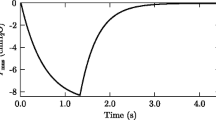Abstract
Misunderstanding of the dynamical behavior of the ventilatory system, especially under assisted ventilation, may explain the problems encountered in ventilatory support monitoring. Proportional assist ventilation (PAV) that theoretically gives a breath by breath assistance presents instability with high levels of assistance. We have constructed a mathematical model of interactions between three objects: the central respiratory pattern generator modelled by a modified Van der Pol oscillator, the mechanical respiratory system which is the passive part of the system and a controlled ventilator that follows its own law. The dynamical study of our model shows the existence of two crucial behaviors, i.e. oscillations and damping, depending on only two parameters, namely the time constant of the mechanical respiratory system and a cumulative interaction index. The same result is observed in simulations of spontaneous breathing as well as of PAV. In this last case, increasing assistance leads first to an increase of the tidal volume (VT), a further increase in assistance inducing a decrease in VT, ending in damping of the whole system to an attractive fixed point. We conclude that instabilities observed in PAV may be explained by the different possible dynamical behaviors of the system rather than changes in mechanical characteristics of the respiratory system.
Similar content being viewed by others
REFERENCES
Bianchi, A. L., M. Denavit-Saubié and J. Champagnat (1995). Central Control of Breathing in Mammals: Neural Circuitry, Membrane Properties, and Neurotransmitters. Physiological reviews 75(1):1–45.
Cherniack, N. S., and G. S. Longobardo (1986). Abnormalities in Respiratory Rhythm. In: N. S. Cherniack and J. G. Widdicombe (ed.), Handbook of Physiology. The Respiratory System. Control of Breathing, sect. 3, vol. II, chap. 22, p. 736–737. Bethesda, MD: American Physiological Society.
Chopin, C. and M. C. Chambrin (1994). Les Boucles d'Asservissement en Assistance Ventilatoire. In: L. Brochard and J. Mancebo (ed.), Ventilation Artificielle. Chap. XII, pp 199–214. Arnette, Paris.
Coleridge, H. M., and J. C. G. Coleridge (1986). Reflexes Evoked from Respiratory Tract. In: N. S. Cherniack and J. G. Widdicombe (ed.), Handbook of Physiology. The Respiratory System. Control of Breathing, sect. 3, vol. II, chap. 12, p. 410–412. Bethesda, MD: American Physiological Society.
Dang-Vu, H., C. Descarte and M. Wysocki (2000). A Mathematical Model of Respiratory System Exhibiting Chaos. International Journal of Differential Equations and Applications 1A(4): 399–408.
Heyer, L. and P. Baconnier (2001). General model for patient-ventilator interactions. In: S.-C. Poon and H. Kazemi (ed.), Frontiers in Modeling and Control of Breathing: Integration at Molecular, Cellular, and Systems Levels. Plenum/Kluwer Press, New York.
Ilya, R. A., J. F. R. Paton and J. S. Schwaber (1997). Modeling Neural Mechanisms for Genesis of Respiratory Rhythm and Pattern. I. Models of Respiratory Neurons. Journal of Neurophysiology 77: 1994–2006.
Jammes, Y. (2000). Physiologie de la Commande Respiratoire. Réanimation-Urgences 9Suppl 2: 70–75.
Linkens, D. A. (1973). Modulation Analysis of Forced Nonlinear Oscillations for Biological Modelling. Journal of Theoretical Biology 77: 235–251.
Marantz, S., W. Patrick, K. Webster, D. Roberts, L. Oppenheimer and M. Younes (1996). Response of Ventilator-Dependent Patients to Different Levels of Proportional Assist. Journal of Applied Physiology 80(2): 397–403.
Navalesi, P., P. Hernandez, A. Wongsa, D. Laporta, P. Goldberg, and S. B. Gottfried (1996). Proportional Assist Ventilation in Acute Respiratory Failure: Effects on Breathing Pattern and Inspiratory Effort. American Journal of Respiratory and Critical Care Medecine 154: 1330–1338.
Otis, A. B., C. B. Mc Kerrow, R. A. Bartlett, J. Mead, M. B. McIlroy, N. J. Selverstone and E. P. Radford (1956). Mechanical Factors in Distribution of Pulmonary Ventilation. Journal of Applied Physiology 8: 427–443.
Pham Dinh, T., J. Demongeot, P. Baconnier and G. Benchetrit (1983). Simulation of a Biological Oscillator: the Respiratory System. Journal of Theoretical Biology 103: 113–132.
Younes, M. (1992). Proportional Assist Ventilation, a New Approach to Ventilatory Support. American Review of Respiratory Disease 145: 114–120.
Younes, M. and W. Riddle (1981). A Model for the Relation Between Respiratory Neural and Mechanical Outputs. I. Theory. Journal of Applied Physiology 51(4): 963–978.
Author information
Authors and Affiliations
Rights and permissions
About this article
Cite this article
Thibault, S., Heyer, L., Benchetrit, G. et al. Ventilatory Support: A Dynamical Systems Approach. Acta Biotheor 50, 269–279 (2002). https://doi.org/10.1023/A:1022616701863
Issue Date:
DOI: https://doi.org/10.1023/A:1022616701863




